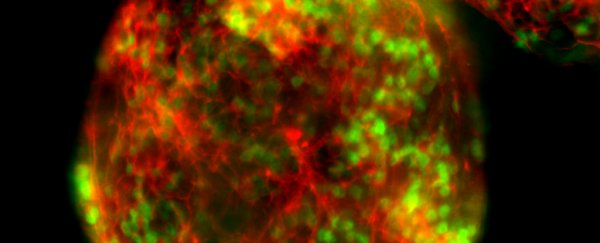A lot has been written about CRISPR over the past year. The powerful gene editing tool can quickly and easily 'cut and paste' genes, which means scientists might be able to use it to edit disease out of human cells, and even prevent genetic disorders in the first place. In November, CRISPR was trialled for the first time on human lung cancer patients.
But despite its potential, it's still very new technology that, like any new technique, has the potential to cause side effects we can't yet predict - which could be really bad if we start using it regularly in humans. The good news is that scientists think they might have found an 'off-switch' that stops CRISPR in its tracks.
"Researchers and the public are reasonably concerned about CRISPR being so powerful that it potentially gets put to dangerous uses," said microbiologist Joseph Bondy-Denomy from the University of California, San Francisco, whose lab performed the research.
"These inhibitors provide a mechanism to block nefarious or out-of-control CRISPR applications, making it safer to explore all the ways this technology can be used to help people."
The problem with CRISPR is that the changes are extremely hard to contain once introduced - genetic changes aren't something you can easily go back and fix later.
This new 'off-switch' isn't capable of reversing any changes already made, but it could quickly stop the system from making any further edits.
CRISPR, or the CRISPR/Cas 9 system, as it's officially called, works like a set of molecular scissors. It was first discovered inside bacteria, where it's used as a genetic weapon to stop bacteria being infected by viruses (yes, even microbes get infected).
Basically how it works is that every time a bacterium is infected by a virus, the bacterium saves a little portion of that virus's DNA locked in a genetic archive called CRISPR, so that it will recognise it for next time.
If it ever gets infected again, this viral DNA is coded into a secret weapon called Cas 9 - an enzyme that hunts down any DNA that matches the one in the archive, and then expertly cuts it out of the bacterium, disabling the virus.
But in 2012, researchers realised that the system could be programmed to cut out whatever they wanted it to. So you add the gene you want cut to CRISPR, and Cas 9 will cut it out.
The problem is, it's still early days for the tool. Although it's far easier to use and more accurate than any genetic editing technique scientists have had previously, we're still learning to master it. Chinese scientists who became the first to use CRISPR on non-viable human embryos back in 2015 admitted the tool still had "significant hurdles" to overcome before its clinical use becomes a reality.
The concern is that Cas 9 could accidentally edit the wrong genes, or that its changes could have unforeseen side effects. Even worse, in the wrong hands, the tool could be used for controversial and unethical purposes, for example, unregulated editing of the human germ line (AKA the creation of 'designer humans').
But the new 'off-switch' could offer a solution that stops the changes caused by CRISPR in their tracks. Not only that, the switch could also make the technique more accurate in the first place.
The switch is a series of 'anti-CRISPR' proteins that were discovered inside viruses that attack bacteria, where they're used to disable the gene editing tool and sneak into the bacterial DNA.
"Just as CRISPR technology was developed from the natural anti-viral defence systems in bacteria, we can also take advantage of the anti-CRISPR proteins that viruses have sculpted to get around those bacterial defences," said lead researcher Benjamin Rauch.
The team isolated these anti-CRISPR proteins from Listeria bacteria that had been infected by viruses.
The researchers realised that if the bacteria's Cas 9 was working properly, they would have started attacking their own DNA, seeing as they'd been infected with a known virus. Because that wasn't happening, something must be switching Cas 9 off.
The team isolated the proteins that appeared to be involved and tested whether any of them could stop CRISPR editing from taking place in human cells.
They found that two of these proteins, AcrIIA2 and AcrIIA4, worked together to inhibit the CRISPR systems commonly used by scientists. They couldn't reverse the genetic changes that had already been made, but they could stop any edits in their tracks by shutting down Cas 9 and preventing it from cutting the genome.
This indicates that the proteins would work to turn gene editing off even outside of the lab, and could shut down any unregulated activity.
The team is now looking into not only developing this 'off-switch' further, but seeing how they could use these proteins to make CRISPR editing more accurate and sophisticated.
"The next step is to show in human cells that using these inhibitors can actually improve the precision of gene editing by reducing off-target effects," said Rauch.
"We also want to understand exactly how the inhibitor proteins block Cas9's gene targeting abilities, and continue the search for more and better CRISPR inhibitors in other bacteria."
We're looking forward to seeing how the tool develops further.
The research has been published in Cell.
